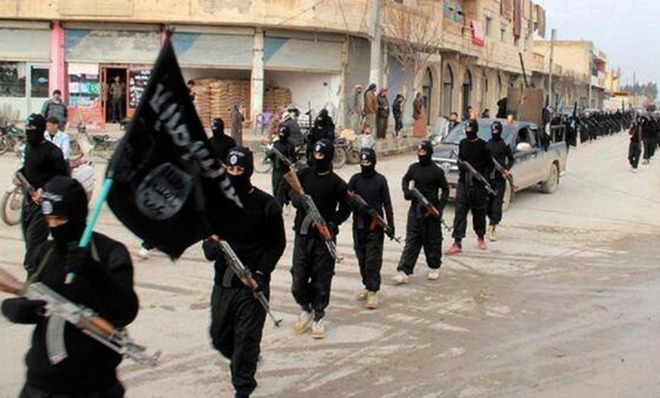How to starve ISIS
It is not a flash-in-the-pan threat


To defeat your enemy, you should know your enemy. If the heart of today's challenge in Iraq is the Islamic State, also known as ISIS (Islamic State of Iraq and Syria), then we must neutralize it. But, how?
The Islamic State's rise was not sudden. Even at its nadir, it was one of the most active terrorist organizations in the world. We simply did not pay enough attention. The lesson of what to do now with Islamic State today is as much about the past as it is about the future.
First, the past: How did the Islamic State become so powerful? The Islamic State is the current incarnation of al Qaeda in Iraq (AQI), which was created when Abu Mus'ab al-Zarqawi swore allegiance to Osama bin Laden in October 2004. The Islamic State of Iraq (ISI) was declared in October 2006, four months after a U.S. airstrike killed Zarqawi. This was not just a naming convention: according to its organizers, AQI ceased to exist at that point, as the ISI was intended to be a governing institution independent from al Qaeda and a practical step toward ultimately declaring a Caliphate.
The Week
Escape your echo chamber. Get the facts behind the news, plus analysis from multiple perspectives.

Sign up for The Week's Free Newsletters
From our morning news briefing to a weekly Good News Newsletter, get the best of The Week delivered directly to your inbox.
From our morning news briefing to a weekly Good News Newsletter, get the best of The Week delivered directly to your inbox.
That intent of the ISI was easily overlooked because the group was weak: in 2007 the Sunni Awakening and the Surge undermined it almost immediately.
The Surge and Awakening did not, however, defeat the ISI. The group retreated to northern Iraq near Mosul, where it survived by capitalizing on tension between Arabs and Kurds, utilizing the logistics networks it had long cultivated to move foreign fighters through Syria, and continued dissatisfaction among Sunnis with sectarianism in the Maliki government.
Despite the setbacks, the ISI remained a capable terrorist organization: between 2008 and 2010 the National Counterterrorism Center tracked more terrorist violence in Iraq than any other country in the world, including Afghanistan and Pakistan.
When the uprising against Syrian President Bashar al-Assad began in the summer of 2011, the ISI did not have to build networks in the Syria. They were already there, and had been supporting its smuggling and foreign fighter operations for years.
A free daily email with the biggest news stories of the day – and the best features from TheWeek.com
In January 2012 the ISI established an organization in Syria called Jabhat al-Nusrah. But Nusrah leader Abu Muhammad al-Jawlani looked to al Qaeda Central for strategic guidance rather than ISI Emir Abu Bakr al-Baghdadi, who asserted his own authority. As a result of this disagreement, the ISI changed its name to the Islamic State of Iraq and the Levant in April 2013, which reflected a de facto severing of ties with Nusrah and a reaffirmation of its split with al Qaeda. In June 2014, after finally capturing its former safe-haven, Mosul, the group was clearly the strongest jihadi entity in the world and declared a Caliphate, with supposed authority from North Africa to South Asia.
There are other reasons for the Islamic State and al Qaeda split. Despite shared lineage and ideology, the two organizations disagree on three basic things: First, whereas al Qaeda prioritizes attacks against the U.S. homeland and Western Europe, the Islamic State prioritizes establishing political authority in the Middle East. That does not mean, however, that the Islamic State poses no threat to Western Europe and the U.S. homeland. The group is so large and multifaceted that it would be surprising if some sub-groups influenced by al Qaeda propaganda did not intend such strikes. More than 11,000 foreign fighters have traveled to Syria, including up to 3,000 from Western Europe and North America. Here, it's important to remember that the Islamic State is not just a terrorist organization. It is proto-state — think the Taliban pre-9/11 — that can offer safe-haven to other militants with more global agendas.
Second, the Islamic State uses a much looser understanding of takfir than al Qaeda, which means that it is more willing to kill Muslims — a fact that is reflected in its battles with other militants. Lastly, the Islamic State believes Abu Bakr al-Baghdadi is Caliph and the supreme authority for all Muslims. Al Qaeda has not formally responded to this claim yet, but the designation has been rejected by many senior jihadi ideologues.
The Islamic State has tenuous alliances with other Sunni factions. In both Iraq and Syria these are based on compulsion and opposition to existing regimes rather than a shared vision of governance. These alliances can be broken.
None of the U.S. policy options toward the Islamic State are particularly attractive. But considering its strengths and weaknesses, U.S. strategy should aim to contain the Islamic State while strengthening governance in the region such that local actors can collaborate effectively to engage it decisively. That means:
- Bolstering allies on the Islamic State's periphery such as Turkey and, in particular, Jordan, which is the most likely new target of the Islamic State.
- Supporting vetted Syrian rebels with appropriate military equipment, so long as that assistance will be sustained. Better not to provide military assistance at all then drop weaponry into a shifting battlefield and then withdraw.
- Providing limited military assistance to Iraq. Blunting the Islamic State's military success is likely to encourage dissension among its coalition partners.
- Pursuing a long-term strategy to improve governance in Iraq and Syria. The goal should be to reduce ungoverned territory however possible, including supporting actors like the Kurdish Regional Government and even Sunni factions that seek increased autonomy from Baghdad or Damascus.
The Islamic State is not a flash in the pan. It will remain a significant threat to U.S. interests in the Middle East for the foreseeable future. Its strength is derived from the chaos caused by our inability to resolve a whole range of related challenges — including whether to oust Bashar al-Assad, how to balance our concern about Iranian influence with the threat from Sunni jihadi groups, and even the degree to which jihadis will attempt to capitalize on the current violence in Israel and Gaza. We can contain it as I have described, but it can only truly be destroyed in conjunction with credible local governments that do not currently exist. The best approach for now is to bolster allies, strengthen our political leadership in the region, creatively undermine the Islamic State, and build for the future.
Sign up to get The Weekly Wonk, New America's digital magazine, delivered to your inbox each Thursday here.
More from The Weekly Wonk...
-
 ‘Care fractures after birth’
‘Care fractures after birth’instant opinion Opinion, comment and editorials of the day
-
 Shots fired in the US-EU war over digital censorship
Shots fired in the US-EU war over digital censorshipIN THE SPOTLIGHT The Trump administration risks opening a dangerous new front in the battle of real-world consequences for online action
-
 What will the US economy look like in 2026?
What will the US economy look like in 2026?Today’s Big Question Wall Street is bullish, but uncertain